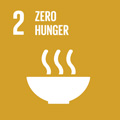- Docente: Sara Bosi
- Credits: 6
- SSD: AGR/02
- Language: Italian
- Teaching Mode: In-person learning (entirely or partially)
- Campus: Cesena
- Corso: First cycle degree programme (L) in Food Technology (cod. 8528)
Learning outcomes
At the end of the course, the student possesses the knowledge on food crops in the appropriate productive and geographical context. He knows the main herbaceous food crops, with particular regard to the qualitative and technological characteristics and the factors affecting them.
Course contents
The course of Ecology of vegetable production and herbaceous crops represents one of the modules of the integrated course of Vegetable production.
Course contents
The plant cell. Structure and components.
Plant tissues. Types of plant tissues: meristems, parenchyma, conductors, mechanics, integument. Mean functions and composition in relation to food uses.
Elements of organography. Vegetative system: stem and leaves; morphology, functions and transformations; composition in relation to food uses. Reproductive apparatus: the flower; reproductive cycle of Angiosperms. The fruit: types, functions and composition in relation to food uses.
Elements of ecophysiology of crops
Knowledge of the main ecophysiological processes of crops; knowledge of environmental factors and their effects.
Plants as producers of organic matter. Photosynthesis. CO2 diffusion. Photochemical and biochemical process. Calvin cycle. Photorespiration. Solar radiation: characteristics and distribution. Interception of radiation. LAI. Relationship between intercepted radiation and CO2 assimilation. C3 and C4 species differences. Effects of CO2 and temperature. Respiration: glycolysis, Krebs cycle, electron transport. Maintenance and growth respiration.
Development and stages of development. Temperature: distribution and effects on plants; development: definitions. Relationships between temperature and development and controlling factors; distribution of assimilates. Determined and indeterminate accretion.
Water and nutrient relationships between plant and environment. Soil; relationships between soil and liquid matrix; water balance; atmospheric water inputs. Evapotranspiration. Radiation balance, net radiation, effects on evapotranspiration. Soil chemical fertility; essential nutrients; organic matter. Chemical fertility; status and balance of P, K, N; forms of nitrogen in plants, nitrate problem.
Quality of Herbaceous Crops
For each of the food crops examined, the following issues will be addressed:
- composition and quality characteristics of the organ used;
- food uses and main technological characteristics;
- worldwide distribution and importance;
- elements of morphology and ecology.
Introduction and classification of food crops.
Cereals. General traits and systematics. Graminaceae: general characteristics, inflorescence morphology. Morphology and composition of the kernel. Cool and warm season cereals.
Wheats. Genus Triticum: evolution and cultivated forms. The cycle, kernels growth. Bread and durum wheat: quality characteristics; commercial quality; milling quality, proteins; amylasic activity; gluten content and quality, technological quality; Chopin alveogram, farinogram. Durum wheat quality. Hints on cropping techniques.
Barley. Feed an malt barley; quality traits for malt production.
Rice. traits, quality characteristics; hints on first processing; hints on cropping techniques.
Corn. traits and uses. Humid and dry milling, products and related quality characteristics; elements of cropping techniques.
Other cereals and pseudocereals.
Oilseed crops. general traits. Processing and main quality traits. Main quality and yield characteristics of soybeans, sunflower, rapeseed. Hints on other oilseed crops.
Food legumes. General traits and quality characteristics. Direct food uses and industrial processing. Main quality traits and production of peas and common beans. Hints on horse beans, lentil, chickpeas, cowpeas.
Sugar crops. Sugar beet: quality and yield characters. Hints on sugar cane.
Potato: composition, quality traits, post harvest physiology; uses and types; growing cycle.
Vegetables for direct consumption or processing. Tomato. Composition and quality traits, with special respect for processing tomato. Cycle and production.
Cucurbitaceae. General traits; vegetable and industry cucumber; hints on melon, watermelon, squashes.
Asteraceae. Artichoke: quality, uses and cycle. Chicories: types, uses; lettuces.
Alliaceae: onion and other species.
Daucaceae: carrot and other species.
Herbs.
Practical lessons: characteristics and morphology of seeds; flour quality exercises; main morphological traits of herbaceous crops.
Readings/Bibliography
Lecture notes and other material provided by the teacher (also available online).
Teaching methods
Frontal lessons
The lectures are held in the classroom, at planned times, assisted by the projection of didactic material. The standard lesson time lasts 45 minutes.
Practical lessons
The practical lessons consist of: laboratory exercises and / or guided tours in farms (according to the availability of the farms).
Assessment methods
The verification of learning will cover the topics covered in the entire program, including the exercises, will be avaluated by an oral test. In particular, knowledge of the topics covered in the program, the ability to connect the topics in a logical-deductive manner, the use of correct language and appropriate technical terminology will be assessed.
The grade for the examination of the entire integrated course in Plant Cultivations will be calculated as a weighted average of the marks given in the two modules of Ecology of Food Production and Herbaceous Crops (6 CFU) and Fruit Science (3 CFU).
Students with learning disorders and\or temporary or permanent disabilities: please, contact the office responsible (https://site.unibo.it/studenti-con-disabilita-e-dsa/en/for-students ) as soon as possible so that they can propose acceptable adjustments. The request for adaptation must be submitted in advance (15 days before the exam date) to the lecturer, who will assess the appropriateness of the adjustments, taking into account the teaching objectives.
Teaching tools
The material presented during the lessons (powerpoint slides) is available to students on the VIRTUALE teaching platform.
Cesena and Bologna didactic laboratory.
Office hours
See the website of Sara Bosi
SDGs


This teaching activity contributes to the achievement of the Sustainable Development Goals of the UN 2030 Agenda.
